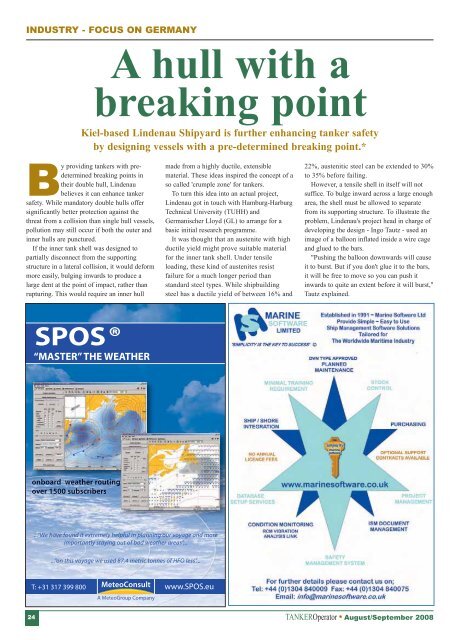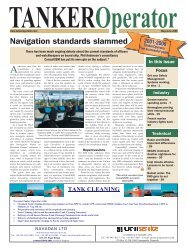Features: - Tanker Operator
Features: - Tanker Operator
Features: - Tanker Operator
You also want an ePaper? Increase the reach of your titles
YUMPU automatically turns print PDFs into web optimized ePapers that Google loves.
INDUSTRY - FOCUS ON GERMANY<br />
By providing tankers with predetermined<br />
breaking points in<br />
their double hull, Lindenau<br />
believes it can enhance tanker<br />
safety. While mandatory double hulls offer<br />
significantly better protection against the<br />
threat from a collision than single hull vessels,<br />
pollution may still occur if both the outer and<br />
inner hulls are punctured.<br />
If the inner tank shell was designed to<br />
partially disconnect from the supporting<br />
structure in a lateral collision, it would deform<br />
more easily, bulging inwards to produce a<br />
large dent at the point of impact, rather than<br />
rupturing. This would require an inner hull<br />
24<br />
SPOS®<br />
A hull with a<br />
breaking point<br />
Kiel-based Lindenau Shipyard is further enhancing tanker safety<br />
by designing vessels with a pre-determined breaking point.*<br />
“MASTER” THE WEATHER<br />
...“We have found it extremely helpful in planning our voyage and more<br />
importantly staying out of bad weather areas”...<br />
...”on this voyage we used 87,4 metric tonnes of HFO less”...<br />
T: +31 317 399 800<br />
MeteoConsult<br />
A MeteoGroup Company<br />
made from a highly ductile, extensible<br />
material. These ideas inspired the concept of a<br />
so called 'crumple zone' for tankers.<br />
To turn this idea into an actual project,<br />
Lindenau got in touch with Hamburg-Harburg<br />
Technical University (TUHH) and<br />
Germanischer Lloyd (GL) to arrange for a<br />
basic initial research programme.<br />
It was thought that an austenite with high<br />
ductile yield might prove suitable material<br />
for the inner tank shell. Under tensile<br />
loading, these kind of austenites resist<br />
failure for a much longer period than<br />
standard steel types. While shipbuilding<br />
steel has a ductile yield of between 16% and<br />
www.SPOS.eu<br />
22%, austenitic steel can be extended to 30%<br />
to 35% before failing.<br />
However, a tensile shell in itself will not<br />
suffice. To bulge inward across a large enough<br />
area, the shell must be allowed to separate<br />
from its supporting structure. To illustrate the<br />
problem, Lindenau's project head in charge of<br />
developing the design - Ingo Tautz - used an<br />
image of a balloon inflated inside a wire cage<br />
and glued to the bars.<br />
"Pushing the balloon downwards will cause<br />
it to burst. But if you don't glue it to the bars,<br />
it will be free to move so you can push it<br />
inwards to quite an extent before it will burst,"<br />
Tautz explained.<br />
TANKER<strong>Operator</strong> � August/September 2008

















